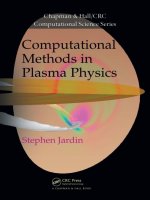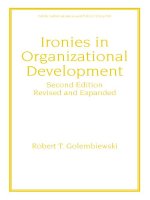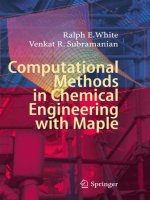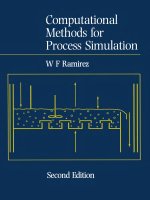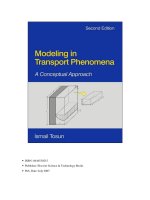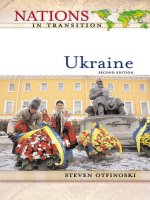computational methods in process simulation, second edition
Bạn đang xem bản rút gọn của tài liệu. Xem và tải ngay bản đầy đủ của tài liệu tại đây (15.4 MB, 473 trang )
Computational Methods
for Process Simulation
This Page Intentionally Left Blank
Computational Methods
for Process Simulation
Second edition
W. Fred Ramirez
Professor of Chemical Engineering
University of Colorado
Boulder, Colorado
r~IUTTERWORTH
i~lE 1 N E M A N N
Butterworth-Heinemann
Linacre House, Jordan Hill, Oxford OX2 8DP
A division of Reed Educational and Professional Publishing Ltd
~A member of the Reed Elsevier plc
group
OXFORD BOSTON JOHANNESBURG
MELBOURNE NEW DELHI SINGAPORE
First published 1989
Second edition 1997
© Reed Educational and Professional Publishing Ltd 1989, 1997
All rights reserved. No part of this publication
may be reproduced in any material form (including
photocopying or storing in any medium by electronic
means and whether or not transiently or incidentally
to some other use of this publication) without the
written permission of the copyright holder except
in accordance with the provisions of the Copyright,
Designs and Patents Act 1988 or under the terms of a
licence issued by the Copyright Licensing Agency Ltd,
90 Tottenham Court Road, London, England WIP 9HE.
Applications for the copyright holder's written permission
to reproduce any part of this publication should be addressed
to the publishers
British Library Cataloguing in
Publication Data
A catalogue record for this book is available from the British Library
ISBN 0 7506 3541 X
Library of Congress
Cataloguing in
Publication Data
A catalogue record for this book is available from the Library of Congress
Printed and bound by Antony Rowe Ltd, Eastboume
CONTENTS
Preface 1
Acknowledgments 3
Introduction 5
Definition of the Problem 6
Mathematical Modeling of the Process 7
Equation Organization 7
Computation 7
Interpretation of Results 8
Limitations of Process Simulation 8
Usefulness of Process Simulation 8
Reference 9
Chapter 1: Development of Macroscopic Mass, Energy~
and Momentum Balances 11
1.1 Conservation of Total Mass 12
1.1.1 Tapered Tube Geometry 13
1.2 Conservation of Component i , 14
1.3 Method of Working Problems 14
1.4 Conservation of Total Energy 19
1.4.1 Tapered Tube Geometry 22
1.5 Method of Working Problems 23
1.6 Mechanical Energy Balance 27
1.6.1 Tapered Tube Geometry 29
1.7 Conservation of Momentum 32
1.7.1 Tapered Tube Geometry 34
1.7.2 Comparison Between Mechanical Energy and
Momentum Balances 34
Problems 38
References 43
Chapter 2: Steady-State Lumped Systems 45
2.1 Methods 46
2.1.1 Partitioning Equations 46
2.1.2 Tearing Equations 47
2.1.3 Simultaneous Solution 47
2.2 Simultaneous Solution of Linear Equations 47
2.2.1 MATLAB Software 53
2.2.2 Linear Algebra Routines in MATLAB 54
2.2.3 Other Matrix Capabilities in MATLAB 64
2.2.3.1 Singular Value Decomposition 64
2.2.3.2 The Pseudo-Inverse 65
2.2.3.3 Sparse Matrices 66
2.3 Solution of Nonlinear Equations 67
2.3.1 Solving a Single Nonlinear Equation in One
Unknown 67
2.3.1.1 Half-Interval (Bisection) 68
vi
Computational Methods for Process Simulation
2.3.1.2 Linear Inverse Interpolation
(Regula Falsi) 70
2.3.1.3 Direct Substitution 73
2.3.1.4 Wegstein Method 75
2.3.1.5 Newton Method 80
2.3.2 Simultaneous Solution of Nonlinear Algebraic
Equations 82
2.4 Structural Analysis and Solution of Systems of
Algebraic Equations 87
2.4.1 The Functionality Matrix 88
2.4.2 An Optimal Solution Strategy 92
2.4.3 Simple Example of Structural Analysis 96
2.4.4 Computer Implementation of Structural Analysis. 99
2.4.5 Mixer-Exchanger-Mixer Design 101
2.4.5.1 Nomenclature for Mixer-Exchanger-
Mixer Design 106
Problems 111
References 122
Chapter 3: Unsteady-State Lumped Systems 125
3.1 Single Step Algorithms for Numerical Integration 125
3.1.1 Euler Method 125
3.1.2 Runge-Kutta Methods 129
3.1.3 MATLAB Runge-Kutta Routines 132
3.2 Basic Stirred Tank Modeling 135
3.3 Multistep Methods 141
3.4 Stirred Tanks with Flow Rates a Function of Level 144
3.5 Enclosed Tank Vessel 152
3.6 Stirred Tank with Heating Jacket 156
3.7 Energy Balances with Variable Properties 158
3.8 Tanks with Multicomponent Feeds 160
3.9 Stiff Differential Equations 162
3.10 Catalytic Fluidized Beds 164
Problems 167
References 176
Chapter 4" Reaction-Kinetic Systems 177
4.1 Chlorination of Benzene 177
4.1.1 Order of Magnitude Analysis for Chlorination
of Benzene 179
4.2 Autocatalytic Reactions 182
4.3 Temperature Effects in Stirred Tank Reactors 184
4.3.1 Mathematical Modeling of a Laboratory
Stirred Tank Reactor 189
4.3.1.1 Experimental 189
4.3.1.2 Modeling 194
4.3.2 Dynamics of Batch Fermentation 198
Problems 209
Contents
vii
References 216
Chapter 5: Vapor-Liquid Equilibrium Operations 217
5.1 Boiling in an Open Vessel 217
5.2 Boiling in a Jacketed Vessel (Boiler) 218
5.3 Multicomponent Boiling~Vapor-Liquid Equilibrium 227
5.4 Batch Distillation 229
5.5 Binary Distillation Columns 231
5.5.1 A Tray 233
5.5.2 The Reboiler 234
5.5.3 The Condenser 235
5.6 Multicomponent Distillation Columns 235
Problems 255
References 256
Chapter 6: Microscopic Balances 257
6.1 Conservation of Total Mass (Equation of Continuity) 257
6.2 Conservation of Component i 259
6.3 Dispersion Description 260
6.4 Method of Working Problems 263
6.5 Stagnant Film Diffusion 263
6.6 Conservation of Momentum (Equation of Motion) 264
6.7 Dispersion Description 266
6.8 Pipe Flow of a Newtonian Fluid 266
6.9 Development of Microscopic Mechanical Energy
Equation and Its Application 272
6.10 Pipeline Gas Flow 274
6.11 Development of Microscopic Thermal Energy Balance
and Its Application 275
6.12 Heat Conduction Through Composite Cylindrical Walls 277
6.13 Heat Conduction with Chemical Heat Source 282
6.14 Mathematical Modeling for a Styrene Monomer
Tubular Reactor 283
6.14.1 Gas Phase Energy Balance 286
6.14.2 Catalyst Bed Energy Balance 290
6.14.3 Equation of Motion 291
6.14.4 Material Balances 292
6.14.5 Steady-State Model Solution 292
Problems 297
References 303
Chapter 7: Solution of Split Boundary-Value Problems 305
7.1 Digital Implementation of Shooting Techniques"
Tubular Reactor with Dispersion 305
7.2 A Generalized Shooting Technique. 311
7.3 Superposition Principle and Linear Boundary-Value
Problems 316
7.4 Superposition Principle" Radial Temperature Gradients
in an Annular Chemical Reactor 320
viii
Computational Methods for Process Simulation
7.5 Quasilinearization 322
7.6 Nonlinear Tubular Reactor with Dispersion:
Quasilinearization Solution 327
7.7 The Method of Adjoints 330
7.8 Modeling of Packed Bed Superheaters 334
7.8.1 Single-Phase Fluid Flow Energy Balance 336
7.8.2 Two-Phase Fluid Flow Energy Balance 339
7.8.3 Superheater Wall Energy Balance 340
7.8.4 Endcap Model 341
7.8.5 Boundary Conditions 343
7.8.6 Solution Method 344
7.8.7 Results 346
Problem 349
References 351
Chapter 8" Solution of Partial Differential Equations 353
8.1 Techniques for Convection Problems 353
8.2 Unsteady-State Steam Heat Exchanger: Explicit
Centered-Difference Problem 355
8.3 Unsteady-State Countercurrent Heat Exchanger:
Implicit Centered-Difference Problem 359
8.4 Techniques for Diffusive Problems 370
8.5 Unsteady-State Heat Conduction in a Rod 372
8.6 Techniques for Problems with Both Convective and
Diffusion Effects: The State-Variable Formulation 374
8.7 Modeling of Miscible Flow of Surfactant in Porous Media. 378
8.8 Unsteady-State Response of a Nonlinear Tubular Reactor 382
8.9 Two-Phase Flow Through Porous Media 392
8.10 Two-Dimensional Flow Through Porous Media 400
8.11 Weighted Residuals 408
8.11.1 One-Dimensional Heat Conduction 409
8.11.2 Two-Dimensional Heat Conduction 412
8.11.3 Finite Elements 413
8.12 Orthogonal Collocation 414
8.12.1 Shifted Legendre Polynomials 414
8.12.2 Heat Conduction in an Insulated Bar 416
8.12.3 Jacobi Polynomials 418
8.12.4 Diffusion in Spherical Coordinates 420
8.12.5 Summary 423
Problems 423
References 430
Nomenclature 431
Appendix A" Analytical Solutions to Ordinary Differential
Equations 435
A.1 First-Order Equations 435
A.2 N th Order Linear Differential Equations with
Constant Coefficients 440
Contents
ix
Reference 444
Appendix B: MATLAB Reference Tables 445
Index 455
This Page Intentionally Left Blank
PREFACE
The purpose of this book is to present a time domain approach to modern
process control. The time domain approach has several advantages including
the fact that process models are naturally developed through conservation laws
and mechanistic phenomena in the time domain. This approach also allows
for the formulation of precise performance objectives that can be extremized.
There is a definite need in the process industries for improved control. New
hardware and software tools now allow the control engineer to consider the im-
plementation of more sophisticated control strategies that address critical and
difficult process control problems. In general, it is necessary to incorporate
process knowledge into the control design in order to improve process opera-
tion. Advanced control designs require more engineering analysis but can lead
to significant improvements in process behavior and profitability.
The reader will notice that I have tried to include practical examples
throughout the book in order to illustrate theoretical concepts. This approach
also allows the reader to be aware of computational issues of implementation
as well as the interpretation of the results of process testing.
Chapter 1 presents basic time domain system concepts that are needed to
mathematically describe an advanced process control problem. The important
concepts of observability and controllability are introduced. Observability is
used in the design of the measurement system, and controllability is impor-
tant for the specification of the control variables of the system. The software
package MATLAB is introduced. It simplifies many of the control design cal-
culations.
Chapter 2 treats the topic of steady-state optimization. Necessary condi-
tions for extrema of functions are derived using variational principles. These
steady-state optimization techniques are used for the determination of optimal
setpoints for regulators used in supervisory computer control.
Chapter 3 gives the fundamental mathematical principles of the calculus of
variations used for the optimization of dynamic systems. Classical results of
the Euler equation for functional extrema and those of constrained optimiza-
tion given by the Euler-Lagrange equation are developed.
Chapter 4 applies variational calculus to problems that include control vari-
ables as well as state variables. Optimal control strategies are developed that
extremize precise performance criteria. Necessary conditions for optimization
are shown to be conveniently expressed in terms of a mathematical function
called the Hamiltonian. Pontryagin's maximum principle is developed for sys-
tems that have control constraints. Process applications of optimal control are
presented.
Chapter 5 considers optimal regulator control problems. The Kalman lin-
ear quadratic regulator (LQR) problem is developed, and this optimal mul-
tivariable proportional controller is shown to be easily computable using the
Riccati matrix differential equation. The regulator problem with unmeasurable
Process Control and Identification
load disturbances is shown to lead to an optimal multivariable proportional-
integral feedback structure.
Chapter 6 develops model predictive control concepts. This structure al-
lows for the inclusion of predictive feed-forward control into the optimal con-
trol problem. We consider design strategies for completely measurable dis-
turbances as well as systems with both measurable and unmeasurable distur-
bances.
Chapter 7 discusses robust control. This allows for the inclusion of uncer-
tainty of process parameters in the control design. The concept of robustness
refers to the preservation of closed-loop stability under allowable variations in
system parameters. General stability results and integrity results are given for
the LQR problem.
Chapter 8 considers optimal control problems for systems that are either
linear or nonlinear in the state variables but are linear in the controls. The
solution of this class of problems leads to bang-bang control strategies. The
existence of singular or intermediate control must also be investigated. Both
time-optimal control and minimum integral square error problems are dis-
cussed.
Chapter 9 develops necessary conditions for optimality of discrete time
problems. In implementing optimal control problems using digital computers,
the control is usually kept constant over a period of time. Problems that were
originally described by differential equations defined over a continuous time
domain are transformed to problems that are described by a set of discrete
algebraic equations. Necessary conditions for optimality are derived for this
class of problems and are applied to several process control situations.
Chapter 10 discusses state and parameter identification. Using uncertainty
concepts, an optimal estimate of the state for a linear system is obtained based
upon available measurements. The result is the Kalman filter. The Kalman
filter is extended for nonlinear systems and discrete-time models. Kalman
filtering is also shown to be effective for the estimation of model parameters.
Chapter 11 presents the use of sequential least squares techniques for the
recursive estimation of uncertain model parameters. There is a statistical
advantage in taking this approach to model parameter identification over that
of incorporating model parameter estimation directly into Kalman filtering.
Chapter 12 considers the combination of optimal control with state and
parameter estimation. The separation principle is developed, which states that
the design of a control problem with measurement and model uncertainty can
be treated by first performing a Kalman filter estimate of the states and then
developing the optimal control law based upon the estimated states. For linear
regulator problems, the problem is known as ~he linear quadratic Gaussian
(LQG) problem. The inclusion of model parameter identification results in
adaptive control algorithms.
ACKNOWLEDGMENTS
This book is a result of the author's research and teaching career in the
area of optimal process control and identification. I gratefully acknowledge
the contributions of my research students to the development of many of the
ideas contained in this book. I have been fortunate to have had a group of
research students who have stimulated new and creative insights into process
control. They deserve credit, for many of the novel and important ideas found
in this work.
Special thanks are due to Ellen Romig who did the technical word process-
ing and layout of this book. Her talents and personal concern for this project
are truly appreciated.
I also thank the University of Colorado for awarding me a faculty fellowship,
which provided the time needed to prepare the final manuscript in the excellent
academic environment of Cambridge University.
Finally, I want to thank my wife, Marion, who has been my personal in-
spiration for many years.
This Page Intentionally Left Blank
INTRODUCTION
Process modeling and computer simulation have proved to be ex-
tremely successful engineering tools for the design and optimization of
physical, chemical, and biological processes. The use of simulation has
expanded rapidly during the past three decades because of the availabil-
ity of high-speed computers and computer workstations. In the chemical
process industry, large, realistic nonlinear problems are now routinely
being solved via computer simulation. Also, the recent trends toward
personal computing and specialized, industrial software allow for the
expanded use of computers in engineering practice. This means that
virtually all engineering computations will shortly be computerized and
engineers need to understand the principles behind available software
and how to effectively use software to solve pertinent process engineer-
ing problems.
The increasing use of computer simulation techniques has broadened
the usefulness of the scientific approach to engineering. Developing com-
petency in process simulation requires that the engineer develop the fol-
lowing skills:
1. A sound understanding of engineering fundamentals: The engineer
must be familiar with the physical system and its mechanisms in
order to be able to intelligently simulate a real process and evaluate
that simulation. The process cannot be viewed as a black box.
.
Modeling skills: The engineer has to be able to develop a set of
mathematical relations which
adequately
describes the significant
process behavior.
@
Computational skills: Rapid and inexpensive solutions to simula-
tion problems must be obtained. The engineer must be capable
of choosing and using the proper computational tool. For realistic
problems, the tool of interest is usually a digital computer. The
engineer must also be able to evaluate and use correctly available
commercial software packages.
Since simulation relies upon a scientific rather than empirical ap-
proach to engineering, it has served to stimulate developments in inter-
disciplinary areas such as bioengineering and environmental engineering.
Engineers have found that they have been able to make significant con-
tributions to society through the successful simulations of biological and
environmental systems. Future fruitful efforts should lie in the model-
ing of political and social systems. Chemical process simulations have
investigated both the steady-state and dynamic behavior of processes.
The tremendous impact that simulation has had on the chemical
process industry is due to the following benefits derived:
Computational Methods for Process Simulation
°
.
o
.
Economic desirability: For design purposes, it is usually cheaper
to use simulation techniques incorporating fundamental labora-
tory data in the mathematical model than it is to build numerous
different-sized pilot plants.
It is a convenient way to investigate the effects of system param-
eters and process disturbances upon operation. It is usually a lot
easier to develop alternative operating approaches and evaluate
these alternatives via a mathematical model than by experimental
methods. In order to verify the simulation results some experi-
ments are usually performed, but only the really critical ones are
necessary.
Simulations are a reasonable way of extrapolating performance and
scaling up processes. By incorporating fundamental mechanisms
into process simulations, system performance can be predicted in
new and different operating regions.
Understanding of the significant process behavior and mechanisms:
By undertaking the rigors of mathematical modeling the engineer
learns much about the process that is being simulated. In order to
obtain a successful simulation, the significant process mechanisms
must be quantitatively described. By solving the model, useful
relations between the process and equipment variables are revealed
and can be easily observed.
The general strategy for the simulation of complex processes follows
a fairly well-defined path consisting of the commonsense steps given
in the accompanying block diagram. Note that information travels in
both directions, indicating the adaptive nature of the development of
any successful simulation.
H Mathematical
Definition of Modeling of
Problem Process
Hill
H Equation H
Interpretation
Organiza- Computation I I Results o f
tion [-~-1
General Strategy of Process Simulation.
DEFINITION OF THE PROBLEM
This is a very important phase of a successful simulation but unfortu-
nately there are very few precise general rules that apply. The real key
to problem definition is an imaginative engineer. What is required is
creative thought based upon sound engineering training. The engineer
must spend sufficient time on this aspect of the problem before proceed-
ing. A good problem definition comes from answering questions such as
Introduction 7
the following: What do I really want to find out? What are the impor-
tant consequences of the study? Why should this job be done? What
engineering effort should be required? How long should the job take?
MATHEMATICAL MODELING OF THE
PROCESS
The engineer is now ready to write the appropriate balance equations and
mechanistic relations for the process. Critical laboratory experiments
must be designed and performed in order to determine unknown mech-
anisms and model parameters. Decisions must be made on which effects
are important and which ones can be neglected. Order-of-magnitude
analysis aids in making these critical simplifying decisions. It is im-
perative that the engineer be aware of and not overlook nor forget the
assumptions made in the development of the mathematical model.
EQUATION ORGANIZATION
Once the mathematical relations have been assembled, they have to be
arranged into a solution strategy, that is, decisions have to be made on
which variable is to be solved for in each relation. For small problems,
we usually perform this function routinely without much thought. How-
ever, for large problems care must be taken. Arranging the equations
in an
information-flow diagram
is recommended. This block-diagram
approach is useful for organizational purposes and illustrates the interre-
lationships among the equation variables. Also, equations should be ar-
ranged so that the solution strategy parallels the logical cause-and-effect
relationships of the physical system. This "natural ordering" (see Franks,
1967) of equations usually leads to stable, efficient solution strategies.
COMPUTATION
For obtaining solutions to process simulation problems, the engineer has
available several levels of computation~ranging from solution by inspec-
tion to analytical and high-speed computer solution. Because of the com-
plexity and nonlinearity of process simulation problems, most solutions
require high-speed digital computer solution. Digital computers are par-
ticularly useful for solving problems involving numerical manipulations.
The FORTRAN language is designed for scientific usage and also has
excellent logic capabilities; it is, therefore, used heavily by experienced
process engineers. Numerical methods for the solution of sets of alge-
braic, ordinary differential, and partial differential equations are needed.
To ease the programming effort in using numerical methods, generalized
Computational Methods for Process Simulation
scientific subroutines have been written. A particularly useful and well-
documented set is that of the NAG library, which is available on both
personal computers and workstations. Additional software packages are
also now available which have excellent graphical capabilities and ease
the programming of specific problems. One popular package is Matlab
(Math Works, Inc.; Sherborn, MA). This is a special interactive software
package developed for use in the solution of algebraic and dynamic re-
sponse problems. A number of Toolboxes are also available for use in
the solution of specific engineering problems such as process control and
process identification.
INTERPRETATION OF RESULTS
The real payoff of the simulation of chemical processes is in the intelligent
interpretation of results by the engineer. At this point, the engineer
must ascertain whether the model is a valid representation of the actual
process or whether it needs revision and updating. The engineer must
make sure that the results seem reasonable. Decisions have to be made
on whether or not the simulated process achieves the objectives stated
in the definition of the problem. Also, reasonable alternatives should be
investigated in an effort to improve performance.
LIMITATIONS OF PROCESS SIMULATION
There are some definite limitations of process simulation of which the
engineer must be aware. These include the following:
1. Lack of good data and knowledge of process mechanisms: The suc-
cess of process simulation depends heavily on the basic information
available to the engineer.
2. The character of the computational tools: There are certain types
of equation sets that still pose a problem for numerical methods.
These include some nonlinear algebraic and certain nonlinear par-
tial differential equation sets.
3. The danger of forgetting the assumptions made in modeling the
process: This can lead to placing too much significance on the
model results.
USEFULNESS OF PROCESS SIMULATION
Computer simulation is playing an increasingly important role in the so-
lution of chemical, biological, energy, and environmental problems. To
Introduction 9
develop some awareness of this discipline, examine the literature of the
past two years, and find a journal article with the application of com-
puter computation and process modeling to the analysis and solution of
a chemical engineering problem. Prepare a short, well-written summary
of the article, in which you provide the following information:
1. The correctly written journal reference for each article.
2. The name of the author(s), where they are located, and their pro-
fessional position.
3. The nature of the problem studied.
4. The method of computation and the size of the problem.
5. The value of the result.
Computers in Chemical Engineering, I~EC Research, AIChE Journal,
Chemical Engineering Communications, and Chemical Engineering Sci-
ence are good sources.
REFERENCE
Franks, R. G., Mathematical Modeling in Chemical Engineering, Wiley,
New York (1967).
This Page Intentionally Left Blank
Chapter 1
DEVELOPMENT OF
MACROSCOPIC MASS,
ENERGY AND
MOMENTUM BAI ANCES
In order to mathematically model a physical process, an engineer must
write appropriate conservation equations for the process and then in-
corporate various mechanistic rate and equilibrium relations into those
equations. Macroscopic conservation balances are written about a finite
control volume and give rise to volume integral expressions for the basic
principles of the conservation of mass, the conservation of energy, and the
conservation of momentum. Since macroscopic balances are written over
a finite control volume, no spatial gradients of the dependent variables
appear in the conservation relations. Dependent variables such as tern-
perature and concentration are therefore not differential functions of the
spatial independent variables within the control volume, but represent
average values over the control volume. The only differential independent
variable is time. Therefore, by using the macroscopic conservation prin-
ciples, mathematical models for unsteady-state processes yield sets of
ordinary differential equations, while models for steady-state processes
yield sets of algebraic equations. This chapter develops macroscopic
mass, energy, and momentum balances and illustrates their use via some
classical problems. The information-flow diagram is used to arrange
the mathematical relations of these illustrations into solution strategies.
Even though, for small problems such as these, we usually perform this
function routinely without much thought, the information-flow diagram,
or block-diagram approach is introduced here so that the reader may de-
velop competency in using the technique before it is really required in the
simulation of more complex problems. Analytical techniques are used to
solve the problems presented in this chapter. Appendix A gives a review
of analytic methods for the solution of ordinary differential equations.
11
12
Computational Methods for Process Simulation
1.1
CONSERVATION OF TOTAL MASS
The conservation principle for total mass which can neither
nor destroyed is (Bennett and Meyers, 1982)"
be created
Rate of Rate of Rate of
Accumulation - Mass Flow - Mass Flow
of Mass In Out
which can be written
Rate of Net Rate
Accumulation of Mass
of Mass Flow Out
This statement is true for all systems except those involving nuclear
reactions.
This conservation principle applied to a general control volume is
illustrated in Figure 1.1. The control volume is located in the fluid
flow field. The velocity at any point on the surface is given by v and
the vector normal to the surface is given by n. The angle between the
velocity vector v and the normal vector n is c~.
Normal, n "
'
" ~,-~ ~_ ~ Velocity, v
Control
volume_ ~ .
Figure 1.1" Control Volume for Conservation Balance.
The conservation principle for mass becomes
a fff
d~ p dV +
net mass flow rate out - 0 (1.1.1)
To obtain the net mass flow rate out, the point value of mass flow
rate must be integrated over the surface of the control volume.
Net mass flow rate out
- f/~ p(v.n) dA
(1.1.2)
Macroscopic Mass, Energy, and Momentum Balances
13
where n is the unit normal vector pointing outward from the surface and
v is the velocity vector.
The (v.n) term is required in order to evaluate the area which is
normal to the velocity direction. Therefore, the overall mass balance
becomes
d
ili , + S I,,("o,
dA
-0
(1.1.3)
The inner product (v.n) can also be expressed as
(v.n) - v cos a (1.1.4)
where v - the magnitude of the velocity vector.
pl i
•Control
volume
¢-,2
I I I#
~
[[
AI
il
iI A-2 II ~?12
n s
Figure 1.2" Simplified Tapered Tube Geometry.
1.1.1 Tapered Tube Geometry
The most common application of the overall mass balance is to a tapered
tube geometry (illustrated in Figure 1.2). Here the velocity is normal to
the surfaces A1 and A2 and parallel to the side surface, S.
For a system in which the density, p, is a constant over the areas
A~ and A2, equation (1.1.3) becomes equation (1.1.5). The density may
vary from plane 1 to 2.
a Sfk
fL
JS~
d~ p dV + Pl vl cos 180 ° dA1 + p2 v2 cos 0 ° dA2
1 2
+ffp~
cos 90 °
dS-O
Defining the average or bulk velocity as
(1.1.5)
1
<.>-
SSA v
.A
14
Computational Methods for Process Simulation
Equation (1.1.5) becomes
d
p dV + p2A2(v}2 - p:A: (v}: - 0
(1.1.7)
Noting that the mass flow rate is defined as
w- pA(v)
(1.1.8)
the overall mass balance is
'///:
d-t p dV
- Wl - w2
(1.1.9)
which is the usual form of the mass balance for this tapered tube system.
The lefthand side is the rate of accumulation while the righthand side is
rate in minus the rate out.
1.2
CONSERVATION OF COMPONENT
i
When considering a mass balance for a component i of a multicomponent
mixture, the rate of generation of the component by chemical reaction
must be taken into consideration. For the simplified tapered tube geom-
etry of Figure 1.2, a mass balance for component i becomes
Rate of
Accumulation
Rate of
= Rate In- Rate Out + Generation
d
d5 f ~/]]V Pi dY - Wil Wi2 AC f /~+r ri
dV
where ri is the rate of generation of species i per unit volume.
(1.2.1)
1.3
METHOD OF WORKING PROBLEMS
It is suggested in working problems involving applications of the macro-
scopic mass balances that the balance equations be developed for the
individual case under study as the first step. In order to check the devel-
opment, the general equations can be simplified to make sure that the
same describing equation set results.
